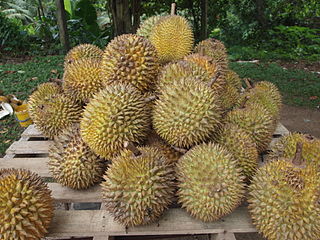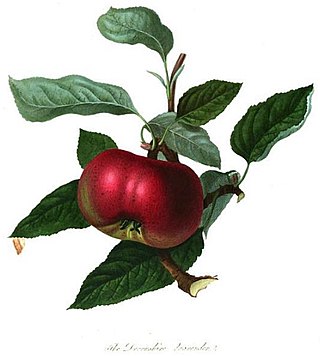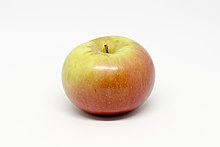
Kiwifruit, or Chinese gooseberry, is the edible berry of several species of woody vines in the genus Actinidia. The most common cultivar group of kiwifruit is oval, about the size of a large hen's egg: 5–8 centimetres in length and 4.5–5.5 cm in diameter. Kiwifruit has a thin, fuzzy, fibrous, tart but edible, light brown skin and light green or golden flesh with rows of tiny, black, edible seeds. The fruit has a soft texture with a sweet and unique flavour.

Cox's Orange Pippin, in Britain often referred to simply as Cox, is an apple cultivar first grown in 1825 or 1830 at Colnbrook in Buckinghamshire, England, by the retired brewer and horticulturist Richard Cox.

A cooking apple or culinary apple is an apple that is used primarily for cooking, as opposed to a dessert apple, which is eaten raw. Cooking apples are generally larger, and can be tarter than dessert varieties. Some varieties have a firm flesh that does not break down much when cooked. Culinary varieties with a high acid content produce froth when cooked, which is desirable for some recipes. Britain grows a large range of apples specifically for cooking. Worldwide, dual-purpose varieties are more widely grown.

Diospyros kaki, the Oriental persimmon, Chinese persimmon, Japanese persimmon or kaki persimmon, is the most widely cultivated species of the genus Diospyros. Although its first botanical description was not published until 1780, D. kaki cultivation in China dates back more than 2000 years.

A pearmain, also formerly spelled "permain", is a type of apple. The name may once have been applied to a particular variety of apple that kept well, although in more modern times its inclusion in varietal names was, like the term 'Pippin', "largely decoration" rather than indicating any shared qualities.

Claygate Pearmain is an apple cultivar. It was found at Claygate, Surrey in England and brought to the attention of the Royal Horticultural Society by John Braddick in 1821. The apple was a popular eating apple in Victorian times and spread through England and to America.

The durian is the edible fruit of several tree species belonging to the genus Durio. There are 30 recognized Durio species, at least nine of which produce edible fruit. Durio zibethinus, native to Borneo and Sumatra, is the only species available on the international market. It has over 300 named varieties in Thailand and 100 in Malaysia as of 1987. Other species are sold in their local regions.

'Dabinett' is an apple cultivar primarily used in cider production in Somerset.

The atemoya, Annona × atemoya, or Annona squamosa × Annona cherimola is a hybrid of two fruits – the sugar-apple and the cherimoya – which are both native to the American tropics. This fruit is popular in Taiwan, where it is known as the "pineapple sugar apple" (鳳梨釋迦), so it is sometimes wrongly believed to be a cross between the sugar-apple and the pineapple. In Cuba it is known as anón, and in Venezuela chirimorinon. In Lebanon, the fruit is called achta. In Tanzania it is called stafeli dogo. In Brazil, the atemoya became popular and in 2011, around 1,200 hectares of atemoia were cultivated in Brazil. In Taiwan, the cultivating area of atemoya was 2,856.46 hectares in 2020, and Taitung County was the major place of cultivating.

'Beauty of Bath' is a dessert apple cultivar.

'Surprise' is a pink-fleshed apple that is the ancestor of many of the present-day pink/red-fleshed apples bred by American growers.

Pristine apple is a hybrid cultivar of 'Co Op 10' x 'Camuzat' domesticated apples, which are descendants of the 'McIntosh' apple and the 'Starking Delicious'. This cultivar was developed and patented in the United States by the PRI disease resistant apple breeding program, in Indiana, United States in 1994, for its resistance to apple scab. It is susceptible to cedar-apple rust.

'Akane', also known as 'Tokyo Rose', 'Tohoku No.3' and 'Prime Red', is a Japanese cultivar of domesticated apple, that according to Orange Pippin is one of the best early season apples.

'Worcester Pearmain' is an early season English cultivar of domesticated apple, that was developed in Worcester, England, by a Mr. Hale of Swanpool in 1874. It was once the most popular cultivar in England for early autumn harvest and is still popular to keep in the garden. It has been extensively used in apple breeding.

Winston is an English cultivar of domesticated apple which was first named Winter King because of its availability in the winter, but was renamed as Winston in 1944 or in 1945, after Winston Churchill.

Dumelow's Seedling is a cultivar of domesticated apple that originated at Shackerstone in Leicestershire where it was grown by Richard Dumeller in 1800. It is known by many other names including 'Dumelow's Crab', 'Wellington', 'Doncklaer', 'Beauty', and 'Belle de Vennes'. The fruit is not ready for harvest until October, being one of the last of the season, and keeps well into the next year. Though inferior for use as a dessert apple it cooks well and in early-20th century England was one of the most valuable varieties of cooking apple.
Katy apple is a Swedish variety raised in 1947 at Balsgard Fruit Breeding Institute, Sweden. Parentage is James Grieve and Worcester Pearmain and it produces heavy crops of bright red fruit. Sugar 12%, acid 8.5 g/litre, vitamin C 6 mg/100g.

The Devonshire Quarrenden is a dessert apple cultivar historically grown and probably originating in England, although it has also been suggested as originating in France. A variety of local names and spellings, including "Red Quarrenden", "Quarrington", "Quarender", and the "Sack Apple", have been recorded in the past.

The 'Blue Pearmain' is an American apple variety, mentioned by Henry David Thoreau in his 1862 essay "Wild Apples."



















